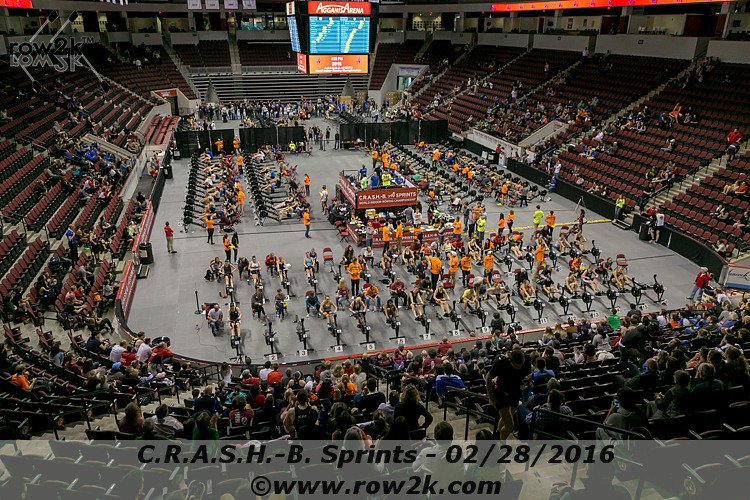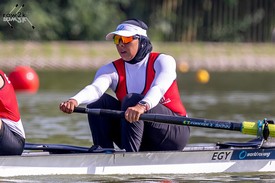Charlotte Hollings

Back in December, we attended a talk by Kris Korzeniowski titled "Ergs Don't Float". We've all heard that saying before, and it's true; if the top ergers were the top rowers, there would be no need to race. But Kris emphasized this a little differently, and I'm paraphrasing here, "The Americans row the erg to be fast on the erg, the Europeans row the erg to be fast on the water."
The erg measures power, and while we need power to row fast, we also need to apply that power correctly. There are many different ergs out there, and some let you practice your balance, others your grip or nesting, but the majority of us are using the Concept2 erg. While it may be more basic (and less expensive) than some other models, there is still a lot of technique work that can be done with it.
Our three overarching tenets of an efficient stroke - horizontal, relaxed, and fluid - can all be improved by time on the erg. Set up mirrors both in front and to the side of the erg, and watch your body and head movement. Work to keep the head and shoulders at the same level throughout the stroke - no vertical motion, no side to side motion, or as I like to say, no extraneous motion. Working to keep the chain level can help keep you horizontal. The more horizontal your stroke, the better able you are to put all your effort into moving the boat forward, toward the finish line.
Relaxation can be a little more difficult to attain, but the goal is to use only the muscles that make the boat go faster. If your forearms or traps are tight and sore after rowing, either on the erg or on the water, you're wasting energy on muscles that are much less effective at moving the boat.
Try to relax the grip, which is easier to do on a stable erg than in the boat. Relax your elbows on the drive so you connect to the lats. Imagine hanging from a pull up bar - your arms are extended but not locked, just like they should be on the erg. Keep the power below the oar handle, using your core, glutes, quads, and lats. As for fluidity, there should be no radical change in speed during any particular part of the stroke. We use the conveyor belt as an analogy: no starting, stopping, speeding up or slowing down; just a steady, continuous speed throughout. When you no longer have tension on the chain, you are done with the drive and therefore, should be on the recovery. Your toes are strapped in to help roll your body out of bow using your lower abdominal muscles.
It's easy to get in the habit of pausing at the finish, taking a little breather perhaps, but every action has an equal and opposite reaction. We are looking for the body and hands to come together out of bow, immediately as we release the blade from the water. While you might not see a huge benefit on the erg, accomplishing this in the boat will help accelerate the boat underneath you. Your body moving to the stern will move the boat in the opposite direction, towards the finish line.
Row the erg for fitness, but remember that the ultimate goal (at least for most of us) is to be faster on the water. Use the erg as a means to that end, not the end itself.
Following are some photos that highlight what we're looking for.




If you enjoy and rely on row2k, we need your help to be able to keep doing all this. Though row2k sometimes looks like a big, outside-funded operation, it mainly runs on enthusiasm and grit. Help us keep it coming, thank you! Learn more.
Comments | Log in to comment |
- Bont Rowing
- Calm Waters Rowing
- Concept 2
- Craftsbury Sculling
- The Crew Classic
- CrewLAB
- Croker
- Durham Boat Co.
- Empacher
- Faster Masters
- Filippi
- Fluidesign
- h2row.net
- HUDSON
- Live2Row Studios
- Nielsen-Kellerman
- Oak Ridge RA
- Peinert Boat Works
- Pocock Racing Shells
- Race1 USA
- RowKraft
- Rubini Jewelers
- Vespoli USA
- WinTech Racing
- Bont Rowing
- Calm Waters Rowing
- Concept 2
- Craftsbury Sculling
- The Crew Classic
- CrewLAB
- Croker
- Durham Boat Co.
- Empacher
- Faster Masters
- Filippi
- Fluidesign
- h2row.net
- HUDSON
- Live2Row Studios
- Nielsen-Kellerman
- Oak Ridge RA
- Peinert Boat Works
- Pocock Racing Shells
- Race1 USA
- RowKraft
- Rubini Jewelers
- Vespoli USA
- WinTech Racing


















12/05/2018 3:43:23 PM